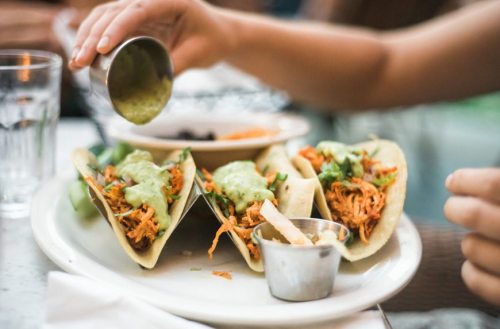Our editors independently select these products. Making a purchase through our links may earn Well+Good a commission
How to re-introduce meat if a fully plant-based diet isn’t working for you
A 100% plant-based diet doesn't work for everyone. Here, dietician Bonnie Taub-Dix gives tips on how to start eating meat again without upsetting your digestive system.

Let’s say you’ve been some type of vegetarian for years, but you’ve recently been craving burgers and bacon. First of all, don’t panic! Sure, this kind of experience can be jarring, but going back to eating meat doesn’t mean you’ve failed at life. Rather, science shows it may be your body’s way of telling you that you’re lacking certain nutrients—or it could be that your dietary restrictions are starting to interfere with your health and happiness.
No matter what your reason for heading back to animal proteins may be, easing into the process is best in order to avoid any weird bodily outbursts. “It’s not just meat that can upset your system,” says dietitian Bonnie Taub-Dix, RDN, creator of Better Than Dieting and author of Read It Before You Eat It: Taking You from Label to Table. “You have to think of where the animal protein is coming from and its fat content. Starting with something like a hamburger after you haven’t had any animal proteins in a while is not the best idea, because it’s fattier. And out of all the macronutrients, fat is the hardest to digest and break down.” (Some experts suggest supplementing with digestive enzymes to help you process foods like this.)
“Starting with something like a hamburger after you haven’t had any animal proteins in a while is not the best idea, because it’s fattier. And out of all the macronutrients, fat is the hardest to digest and break down.”
For this reason, Taub-Dix recommends reintroducing leaner proteins first, like fish or turkey, and staying away from anything too greasy. She also suggests limiting your meat intake in the beginning and keeping portion sizes small. “Bacon with breakfast, pastrami for lunch, and steak for dinner is probably not a good idea at first,” she says. Instead, think of animal proteins as a garnish for your meals, rather than the main event. “Have the plant foods continue to take on the starring role—for example, a pasta dish with cut-up veggies and a little bit of poultry, or a big salad with some pieces of fish.”
The most important thing to keep in mind, though, is to listen to your body. “There isn’t any specific timeline of what to re-introduce when. I would just say to play it by ear and ease into it,” Taub-Dix says. And, she stresses, don’t forget about your favorite veggies as you’re getting reacquainted with salmon bowls and scrambled eggs. “Continue eating all those fruits and vegetables—they are the best for you!” Don’t worry, kale, we’d never quit you.
It is possible to have your “meat” and your vegetables, too. Exhibit A: Next-gen veggie burgers that closely replicate the real thing. If salad fatigue’s your issue, check out this chef-approved tip for keeping things interesting.
Sign Up for Our Daily Newsletter
Get all the latest in wellness, trends, food, fitness, beauty, and more delivered right to your inbox.
Got it, you've been added to our email list.










